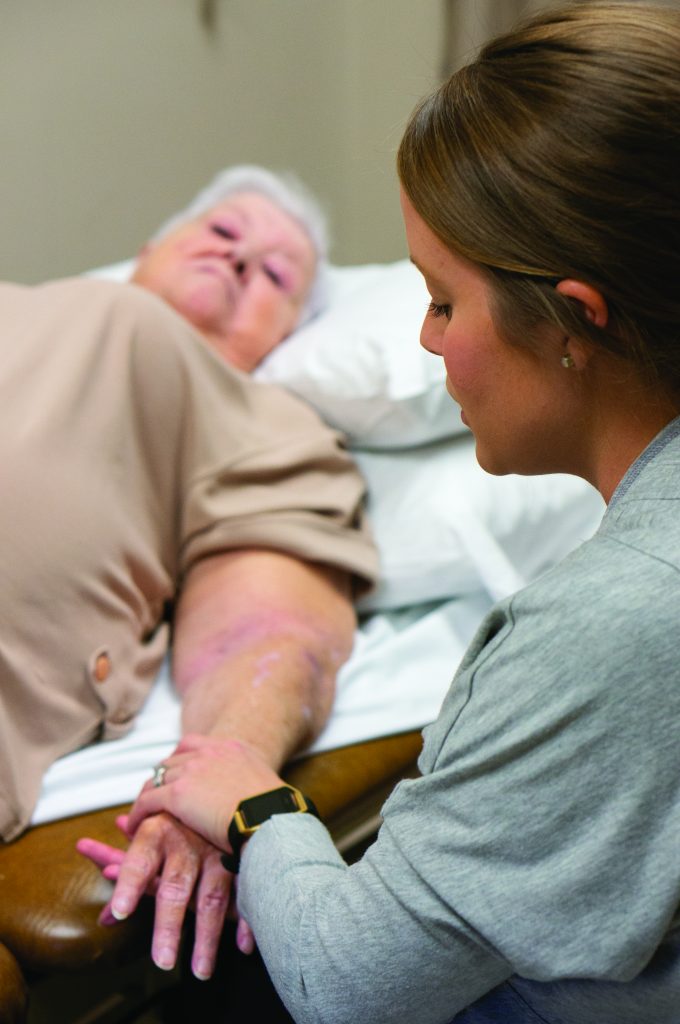
It’s Worth DOING
By Jessica Park
Shirley Padgett, of Marceline, Mo., was born and raised in nearby Laclede.
“Laclede is the home of General John J. Pershing,” she notes, referring to the commander of the American Expeditionary Force in World War I. As a girl, Shirley had spent time in the Pershing home, when it was still a private residence and hadn’t yet been designated a historical site. The homeowners had no children and welcomed Shirley into their house, where she had explored and played dress-up in garments that once belonged to the general’s daughter.
Shirley has fought her own battles as a breast cancer survivor. About 13 years ago, she underwent a mastectomy and had lymph nodes removed from under her left arm. Years later, her left arm began to swell. It didn’t hurt, but it felt tight and heavy. And the swelling wouldn’t stop.
“My arm ballooned to three times the size of my other one,” Shirley says.
Lymphedema causes swelling in the arms or legs, on one or both sides. The swelling results from a blockage or disruption in the lymphatic system, which plays a role in our immune system. Lymph fluid builds up in the arms or legs, making them swell.
Lymphedema frequently affects cancer survivors and can occur months to years after treatment. Cancer treatments, like surgery or radiation therapy, can affect the lymph nodes and lymph vessels. Breast cancer treatment is a common cause of upper-extremity lymphedema, because lymph nodes near the breast must be removed to see if the cancer has spread.
According to Elsa Oestreich, a Certified Lymphedema Therapist and Occupational Therapist with Boone Therapy, some people who have lymphedema are born with decreased lymphatic system function.
Elsa explains, “When someone is born with it, it is called primary lymphedema. When someone, like Shirley, develops it after a surgery or lymph node removal or radiation, it is called secondary lymphedema.”
Lymphedema isn’t painful, but the swelling can be uncomfortable or restrict movement. If left untreated, lymphedema can lead to infections and, in very rare cases, a kind of cancer called lymphangiosarcoma.
Shirley’s primary care doctor referred her to Boone Therapy in Columbia to treat her swollen arm.
During her appointment, Shirley relaxes on the therapy table as Elsa massages her left arm. Elsa explains that this therapeutic massage, called manual lymphatic drainage, “directs fluid from Shirley’s arm to different areas of the body, where she has more viable lymph nodes.”
The manual lymphatic drainage lasts about 40 minutes. To prevent the fluid from returning into Shirley’s arm, Elsa follows up by wrapping the arm with compression bandages. Elsa also gives Shirley instructions on buying fabric compression sleeves she can wear on her arm.
“Shirley will bring the sleeves next week, so we can ensure they fit well and she knows how to put them on correctly,” Elsa explains.
Most patients with lymphedema usually benefit from about 8 to 12 sessions of occupational therapy, where they receive treatment in the clinic and learn ways to care for their condition at home.
“I usually spend a lot of time educating the patient and family on good skin and nail care to avoid infections of the arm or the leg. There are also a few things they can do to avoid more swelling, so we talk about risk reduction and infection prevention,” Elsa says.
Occupational therapy sessions also include therapeutic exercise to further help the patient drain excess fluid from their affected limb.
In between Shirley’s appointments at Boone Therapy, she had some homework. Elsa gave Shirley instructions showing how to wrap her arm with the compression bandages. Shirley says her grandson, Tim Akin, helps her every day with the wrapping.
“It’s hard, but I know it’s worth doing,” Shirley says.
Tim, who also drives Shirley from Marceline to her appointments, says he’s glad that his grandmother didn’t have any pain during her therapy sessions and says that her arm looks better.
“For lymphedema treatment, we measure both arms or legs to compare the affected to the non-affected side. Then we measure the circumference of the affected limb to confirm progress,” Elsa says, noting that since Shirley first came to Boone Therapy, her arm has shrunk by 30 centimeters in circumference.
Shirley loves the care she’s received and says her time at Boone Therapy is definitely worth the 3-hour round trip to Marceline. Once she arrives, she’s never kept waiting for her scheduled appointment.
“I’ve appreciated the kindness and the punctuality,” Shirley says. “And Elsa has become very special to us. I wouldn’t trade her for 10 other people!”